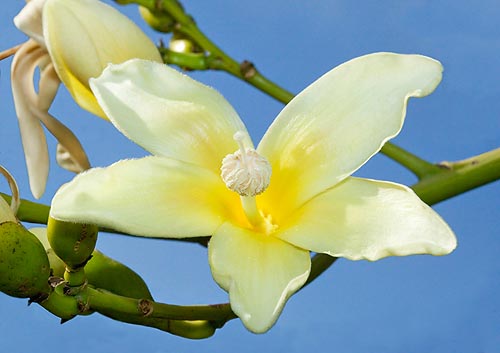Family : Malvaceae

Text © Pietro Puccio

English translation by Mario Beltramini

A 15 m tree with waxy flowers which may have a 15 cm diametre © Giuseppe Mazza
The Ceiba insignis (Kunth) P. E. Gibbs & Semir (1988) is native to Ecuador and Peru, where it grows in the savannas and in the mainly xerophytic, deciduous, forests.
The name of the genus comes from the name given by the natives of the Caribbean to some plants of the genus (in particular, the Ceiba pentandra); the name of the species is the Latin word “insignis” = remarkable, extraordinary.
Common names: “bottle tree”, “drunken tree”, “white silk floss tree” (English); “arbre bouteille”, “chorisia jaune”, “kapockier” (French); “albero bottiglia”, “chorisia”, “falso kapok” (Italian); “paineira-barriguda branca”, “paineiera branca” (Portuguese); “algodon”, “árbol de lana”, “kapoc”, “painera”, “palo barrigudo”, “palo borracho de flor blanca”, “palo botella”, “tobaroche”, “toborochi” (Spanish); “Flaschenbaum” (German).
Deciduous leaf tree, tall up to about 15 m, with trunk swollen in the lower part, with a diameter of 1-2 m, with tender and porous wood and green bark in the young specimen, green-grey in the adult ones, covered by conical thorns; the leaves are palmate-compound, with 5-7 oblong-obovate, 6-10 cm long and about 4 cm broad leaflets, with sharp apex, of a glossy green colour on the upper side, green-grey in the lower one, on an about 8 cm long petiole.
The flowers are hermaphrodite, waxy, with a diameter of about 15 cm, with five oblong white or cream-white petals with undulated edges and with a showy staminal tube, long about 5 cm, at its centre.
The fruits are dehiscent (fruits which open spontaneously when ripe along the lines of minor resistance, freeing the seeds), oblong, 10-15 cm long capsules, containing several seeds dipped in a white woolly mass.
It easily reproduces by seed, which germinates in about one month, on a sandy substratum.
Plant of great landscape value, due to its imposing bottle-shaped, spiny, greenish, trunk, and for its showy, abundant blossoming taking place at the same time of the fall of the leaves.
Suitable to tropical, subtropical and warm temperate climates, as it can resist, when adult, for short time to temperatures of -6°C, it is to be placed in full sun, in well draining soils, keeping in mind that its rooting apparatus is particularly aggressive and rather superficial, it is therefore to be placed well far from walls, enclosures, sidewalks, sewers, etc.
Fast growing, it can bear long drought periods, as it stores water, during the rainy season, inside its spongy wood. The spines can be rather easily taken off in the areas where they can represent a damage, at man’s height, even if this, of course, compromises one of its particular characteristics.
In pot, thanks to the particular shape of its trunk and its superficial roots, it is an appreciated subject of the collectors of caudiciform plants and for realizing bonsais.
The silky fibres which wrap the seeds are utilized for stuffing, as replacement of the “kapok” (the fibres obtained from the fruits of the Ceiba pentandra), and for thermal insulators.
Synonyms: Chorisia insignis Kunth (1822); Chorisia integrifolia Ulbr. (1916).
→ To appreciate the biodiversity within the MALVACEAE family please click here.
